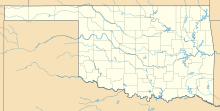
Back Angriff am Washita German Bataille de la Washita French Bloedbad fan de Washita Frisian טבח ואשיטה HE Battaglia del Washita Italian ウォシタ川の戦い Japanese Bloedbad van Washita Dutch Masakra nad Washita River Polish Битва при Уошите Russian
| Battle of the Washita River | |||||||
|---|---|---|---|---|---|---|---|
| Part of the Indian Wars | |||||||
 Battle of Washita from Harper's Weekly, December 19, 1868 | |||||||
| |||||||
| Belligerents | |||||||
|
| Cheyenne | ||||||
| Commanders and leaders | |||||||
|
| Black Kettle †[1] | ||||||
| Strength | |||||||
| 574 soldiers | 150 warriors (est.);[2] total camp population 250 (est.)[3] | ||||||
| Casualties and losses | |||||||
| 21 killed and 13 wounded |
Range of military and civilian scout estimates: * 16 to 140+ men killed * "some" to 75 women and children killed Range of Cheyenne estimates: * 11 to 18 men killed * 17 to "many" women and children killed Total: *Estimates range from 13 to 150 total killed; 53 women and children captured See discussion below for further information and sources. | ||||||
Location within Oklahoma | |||||||
The Battle of the Washita River (also called Battle of the Washita or the Washita Massacre[4]) occurred on November 27, 1868, when Lt. Col. George Armstrong Custer's 7th U.S. Cavalry attacked Black Kettle's Southern Cheyenne camp on the Washita River (the present-day Washita Battlefield National Historic Site near Cheyenne, Oklahoma).
The Cheyenne camp was the most isolated band of a major winter encampment along the river of numerous Native American tribal bands, totaling thousands of people. Custer's forces attacked the village because scouts had found it by tracking the trail of an Indian party that had raided white settlers. Black Kettle and his people had been at peace and were seeking peace. Custer's soldiers killed women and children in addition to warriors, although they also took many captive to serve as hostages and human shields. The number of Cheyenne killed in the attack has been disputed since the first reports.
- ^ Black Kettle and Little Rock were the two known chiefs in the village that was attacked, and both were killed. However, as chiefs they were not military commanders. According to George Bent, "The whites have the wrong idea about Indian chiefs. Among the Plains Indians a chief was elected as a peace and civil officer and there was no such office as war chief. What the whites call war chiefs were only warriors of distinction.... But the Indian idea of a chief is not a fighter, but a peace maker." Bent 1968, p. 324.
- ^ Greene 2004, p. 111.
- ^ Greene 2004, p. 103.
- ^ Hoig, Stan (1979). The Battle of the Washita: the Sheridan-Custer Indian campaign of 1867–69. Lincoln, NE: University of Nebraska Press. p. 189. ISBN 0-8032-2307-2.
© MMXXIII Rich X Search. We shall prevail. All rights reserved. Rich X Search
